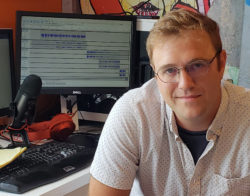Community Remix in Progress: Sonic Collage as Methodology for Studying New Materialist Publics
In a recent Rhetoric Society Quarterly review of four contemporary books on public rhetorics, Nathaniel Crick argues that each book’s author establishes a dichotomy between an ideal public they consider real and an actual public they consider unreal. Largely, Crick uses this un/real terminology to claim that each author finds existing publics deficient when compared to the ideal ways they believe publics should behave. He asserts that instead of comparing actual publics to fictional, romantic, or nostalgic ideals, scholars should focus on understanding publics as they exist. This approach invites scholars to consider publics in material, rather than formal, terms by suggesting that publics are not defined by a shared Platonic identity but rather are uniquely composed by a confluence of human and nonhuman actors interacting with one another.
A new materialist comportment to publics that focuses on how embodied actors operate in the world rather than how scholars think they should invites the development of new methodologies for studying publics in their specific singularness, seeing them as materially composed by complex social meshworks of human and nonhuman actors whose embodied interactions shape their worlds. The problem with such methodologies, however, is that the specificity they demand is difficult to enact. The actors who compose a public are always shifting and, if scholars attend to nonhumans with any degree of specificity, are perhaps innumerable; similarly, the rhetorical actions and associations connecting actors within a public are subtle and at times ineffable.
In the face of the problem of specificity, I suggest that the medium of sound, because it operates in a manner uniquely intimate and affective, can enable public rhetoric scholars to better represent the multifaceted relationships among actors that compose publics. Specifically, I argue that the creation of sonic collages—a term almost synonymous with Jean Bessette’s “audio collage” that I use to describe curated soundscapes composed of short audio samples—if thoroughly researched, can help public rhetoric scholars present versions of publics that are more nuanced and emotionally intelligent than written accounts alone. Though all representations of publics are limited because researchers filter the lived experiences of others through their own perspectives to create representative compositions, sonic collages uniquely allow for a multitude of material voices to participate within compositions that highlight each participant’s singular corporeality. The embodied voices of actors demonstrate their singularness, making it difficult for the researcher to make abstract comparisons or claim the public they are studying is unreal.
In this article, I define a conception of new materialist publics that roots itself not in idealized forms of communication but in embodied material and social relationships among human and nonhuman actors—a concept that should compel public rhetoric scholars to see all publics as real, regardless of their discourse practices. Building on this definition, I examine how sound enables public rhetoric scholars to listen to unique actors, represent the singularness of their embodied experiences, and create scholarship that invites the audience to empathize and understand themselves as interconnected with the public described. Finally, I end this article by offering an annotated version of my own sonic collage on the history of the Los Angeles street gang the Crips as an example of how to enact this methodology. My collage does not claim to be a definitive history of the Crips; rather, it serves as an example of how to acknowledge the embodied realness of a public.
Defining a New Materialist Public
In The Human Condition, Hannah Arendt defines the public sphere as “the world itself, in so far as it is common to all of us and distinguished from our privately owned place in it” (52). This definition sees the public not as a crude realism but as a complex world curated by humans to relate and separate them both from each other and from nonhumans. This public is defined by its plurality of people; it is the place in which diverse groups of people discuss, argue about, and reform their shared world. All that is demanded of the involved parties is that they agree they share a world and acknowledge that they occupy it in different material and social ways that influence how they understand it, interact with it, and wish to see it changed.
Arendt contrasts this deliberative public sphere with the conversational social sphere, which she defines as, “the collective of families economically organized into the facsimile of one super-family” (29). In the Arendtian social, private interests assume public significance, and distinctions and differences are erased by shared outlooks and values to the point that behavior replaces action as the “foremost mode of human relationship” (44). In other words, whereas the public is focused on politics, action, and difference, the social is concerned with culture, behavior, and conformity. Despite the differences between the two spheres, Arendt argues that in the modern world they are not particularly distinct: “the two realms indeed constantly flow into each other like waves in the never-resting stream of the life process itself” (33).
The blurriness that exists between the public and the social in contemporary culture is evident in the way new materialist philosophers understand social to mean something reminiscent of Arendt’s public. In his 2005 book Reassembling the Social, Bruno Latour defines the social as an aggregate of human and nonhuman actors joined together in complex networks by relationships as diverse as chemical bonds, legal systems, gravity, and lust that influence how actors coexist in the world. For example, people becoming couch potatoes are enabled by their networked associations with televisions, remote controls, the media industry, and a number of other actors (77). Beyond lazy days, such new materialist thinking has serious political ramifications. If actions emerge from the interactions of human and nonhuman actors, then the public sphere should consider how those relationships can be adequately and justly governed.
Taking emergent actions seriously asks humans to enact politics in a way that is more open to the diversity of the world than Enlightenment models of representative governance allow. In “From Realpolitik to Dingpolitik,” Latour argues that representative governments are organized spatially, symbolized by the gigantic domes that gather-up political assemblies under a common roof, in order to generate cohesive collective identities among humans in a relationship that is reminiscent of Arendt’s social. This kind of sociality attempts to erase difference. The concerns, discourses, and perspectives of those populations beyond the socially dominant public are silenced, which is a problem for many humans and many nonhumans.
In contrast to the social hegemony of parliamentary systems, Latour asks his readers to consider the assemblies of old Nordic and Saxon cultures who would meet at dings, which were understood as both material spaces and shared understandings of place that would unite people by stressing their different perspectives on their shared world in a system similar to Arendt’s public. For Latour, some of the primary actors present in ding politics were objects, which were considered actors because they influenced others, were influenced by others, and were entangled in the concerns of humans. Latour argues that if human actors are to consider nonhumans as actors, realizing that they have shared concerns, then they need to find ways of engaging with them as neither brute matter nor socially constructed symbols. There are ways to engage members of the public whose perspectives are different from the dominant model.
Jane Bennett explains such a relationship in her book Vibrant Matter by arguing that the public efficacy of nonhumans can be seen by examining the habits of worms. Combining Charles Darwin’s notebooks on the creatures—which demonstrate their conscious decision making—with a case study of worms changing the aluminum content of a patch of soil in the Amazon—which enabled forest plants to thrive in grasslands—Bennett argues that worms act in ways that have repercussions for our shared world. If, like Arendt and Latour, public rhetoric scholars understand the public sphere as a realm of differentiation and action, then they should also see worms are a part of the public. Moreover, they should acknowledge that there exists a myriad of nonhumans who act in politics such as bacteria, hurricanes, and pollen to name a few.
With all of this in mind, a new materialist public understands plurality to mean that though all members of a public share a common world in which they enact agency, they do not necessarily hold the same beliefs, concepts, identities, understandings, or even species-being. In the last decade, the field of composition and rhetoric has begun to embrace this kind of radical, meshwork plurality. Books such as Laurie Gries’s Still Life with Rhetoric, and the edited collections Thinking with Bruno Latour in Rhetoric and Composition and Rhetoric through Everyday Things have challenged rhetorical thinking on what it means for objects to be rhetorical actors within complex publics, while acknowledging that studying these publics requires new innovative methodologies and methods.
The methodology of sonic collage provides one way of engaging this material complexity by emphasizing the sounds of public interactions rather than relying on written descriptions. Sound not only highlights the singular nature of ambient noises, embodied voices, musics, and spaces but also demonstrates the ways in which the interactions among material bodies provide each sample with an affective quality that transcends traditional understandings of meaning. Combined, these samples create a nuanced depiction of a public that emphasizes the realness of the public that is irreducible to the abstract criteria necessary for comparison.
Listening through Sonic Collage
Sonic collage emphasizes the singular realness of specific publics because of the way in which sound waves create communion between material bodies when they permeate the perceived borders between them. Anyone who has felt bass rattle in their chest can attest to the way in which sound resonates with the body. Similarly, neurologists and psychologists are currently studying how sound affects the brain and builds feelings of community (Fields; Storr; Wilkins). Such interconnectedness has little to do with meaning; rather, sound establishes what Diane Davis refers to as “an affective report that operates in excess, at the very least, of interpretive meaning.” The importance of sound is how its materiality affects corporeal bodies, demonstrating the realness of both those making noise and those listening to it.
Sound’s relationship to the reality of the body is articulated in Roland Barthes’s argument that the best singers have voices with a unique grain to them: an attribute that makes them distinct from other voices and demonstrates the individuality of the bodies from which they emerge. Similar to his more popular concept of the punctum, the grain of the voice establishes a direct personal connection between the unique physical body of the performer and those of the audience (188). Recent scholarship in composition, such as John Barber’s audiobiography of the 1960s and Jonathan Alexander’s analysis of Glenn Gould’s “The Idea of North,” demonstrates that such connections can be made by voices speaking as well as those singing. Barber demonstrates how the voices of 1960s news broadcasters helped him to see himself as intimately connected to the broader culture of the United States, whereas Alexander demonstrates that Gould’s radio play united a variety of voices into a pluralistic public that invited audiences to participate in co-creating the community.
When creating my sonic collage, I, like Gould, wanted to present a pluralistic public composed of both human and nonhuman actors. I wanted to invite the audience to engage this public and realize the ways in which they have always been implicated in its existence. I wanted to compose what Cynthia Haynes would call “a hearing” that responds to the public as an auditor rather than an orator (143). I wanted to listen, take note, and distribute my understandings of the public in a way that would neither violently appropriate the group nor dictate an understanding of them. I specifically composed with sound so as to represent the Crips as what Annemarie Mol refers to as a “multiple object” that ontologically changes depending on its actors, interactions, and contexts (5). I knew that any representation of this public would do violence to it, but I attempted to mitigate this as best I could by demonstrating the specific embodied realities and complexities of the Crips. The methodology of the sonic collage provides me a way to do this by attending to both human and nonhuman actors. Additionally, adding footnotes to the transcript enabled me to add context for readers unfamiliar with the topic. To avoid creating a hierarchy among sounds, every sample is accompanied by a footnote.
The sonic collage combines sounds to tell a history of the Crips as both singular and multiple, both corporeal and conceptual, both co-produced and idiosyncratic. This history is different than the narratives told in documentaries like Crips and Bloods Made in America, Inside the Bloods and Crips, and Bastards of the Party, all of which explain how the Crips formed in the power vacuum left by the fall of the Black Panther Party in the 1960s, rose to prominence through violence in the 1970s, gained power during the crack epidemic of the 1980s, and then declined due to both mass incarceration and rising community consciousness in the early 2000s. This common narrative is accurate, but it fails to account for the complexity of human and nonhuman relationships that compose the public. By juxtaposing a variety of voices, the sonic collage invites an understanding of the Crips that is less linear and more emergent than that espoused by the dominant narrative.
Another important source of inspiration for this project was Public Enemy’s production team the Bomb Squad. As Chuck D explains, the thick sonic collages that became the trademark of the group “create a new sound out of the assemblage of sounds that made us have our own identity.” The Bomb Squad remixes the publics they are a part of to create something new—something that transcends meaning and must be always created anew by its listeners. Similarly, my sonic collage is an amalgam of sounds taken from documentaries, interviews, and memoirs about the Crips, their influences, and their relationships with the dominant public that I combined using the sound editing software Audacity. Some of the sounds were originally found in MP3 format, but many had to be converted using video to MP3 converters. In the case of the written memoirs, I recorded readings of select passages. In this way, the collage is a composite not only of voices and perspectives but also of formats, media, and modes of expression. I am not vain enough to think this project will have the longevity of Fear of a Black Planet or It Takes a Nation of Millions to Hold Us Back, but I do hope that it provides audiences a chance to reconsider not only the Crips but also new materialist publics, sonic rhetorics, and the methodology of the sonic collage. With this is mind, I present “Community Remix in Progress: Retelling the History of the Crips.”
Transcript_CommunityRemixinProgress
Works Cited
- “!!The $65 LA Gang Tour (Ghettotainment)!!.” Youtube, uploaded by NEWZANDNATURE, 7 Mar. 2010, www.youtube.com/watch?v=W_9HS4Nnr5E&t=66s.
- “2pac feat Dr.Dre – California Love HD.” Youtube, uploaded by RedDome1995, 30 Dec. 2010, www.youtube.com/watch?v=5wBTdfAkqGU.
- Alexander, Jonathan. “Glenn Gould and the Rhetorics of Sound.” Computers and Composition, vol. 37, 2015, pp. 73-89.
- Alexander, Michelle. The New Jim Crow: Mass Incarceration in the Age of Colorblindness. The New Press, 2012.
- “All Day (Live at the 2015 Brit Awards) (Explicit).” Youtube, uploaded by KanyeWestVEVO, 13 Mar. 2015, www.youtube.com/watch?v=_ABk7TmjnVk.
- “Anderson . Paak – The Dreamer (feat. Talib Kweli & Timan Family Choir).” Youtube, uploaded by Anderson .Paak, 15 Jan. 2016, www.youtube.com/watch?v=Jv95aptVSUk.
- Arendt, Hannah. The Human Condition. U of Chicago P, 1998.
- Asen, Robert. “Representing the State in South Central Los Angeles,” Counterpublics and the State, edited by Robert Asen and Daniel C. Brouwer, State U of New York P, 2001, pp. 137-160.
- Barber, John F. “Audiobiography: A Sonic Memoir of the 1960s.” Harlot, vol. 9, 2013.
- Barthes, Roland. “The Grain of the Voice.” Image Music Text, translated by Stephen Heath, Fontana, 1977.
- Bennett, Jane. Vibrant Matter: A Political Ecology of Things. Duke UP, 2010.
- Bessette, Jean. “Audio, Archives, and the Affordance of Listening in a Pedagogy of Difference. Computers and Composition, vol. 39, 2016, pp.71-82.
- “Black Panther Chants from 1968.” Youtube, uploaded by Shroomeryslearyfan, 24 July 2010, www.youtube.com/watch?v=ZrfuPoz4dtI.
- “Bloods & Crips – Banging on Wax (Full Album).” Youtube, uploaded by Justin Funk, 25 Jan. 2014, www.youtube.com/watch?v=sPuydWhzD0Q&t=141s.
- Carmichael, Stokely, and Charles V. Hamilton. Black Power: The Politics of Liberation. Vintage, 1976.
- Crick, Nathan. “Publics and Intellectuals, Both Real and Unreal.” Rhetoric Society Quarterly, vol. 46, no. 2, 2016, pp. 176-93.
- “crip anthem.” Youtube, uploaded by stevenrunescape, 5 Dec. 2007, www.youtube.com/watch?v=CWSOKdJq8Jk.
- “Crips and Bloods Made in America 2008.” Youtube, uploaded by Arts Entertainment Sports, 3 July 2008, www.youtube.com/watch?v=b_VDWLBhsDM&t=562s.
- “Curtis Mayfield – Diamond in the Back.” Youtube, uploaded by scarface115, 18 Apr. 2011, www.youtube.com/watch?v=ZVANQheoRUw.
- Davis, Diane. “Introduction to Special Issue.” Currents in Electronic Literacy, 2011.
- “dead prez – Hell Yeah (Explicit).” Youtube, uploaded by deadprezVEVO, 25 Oct. 2009, www.youtube.com/watch?v=kGjSq4HqP9Y.
- “Dead Prez.” Youtube,uploaded by Jessica Bander, 14 Aug. 2008, www.youtube.com/watch?v=BpipOqP_1C0.
- “Drop It Like It’s Hot by Snoop Dogg ft. Pharrell Interscope.” Youtube, uploaded by Interscope Records, 4 June 2009, www.youtube.com/watch?v=RaCodgL9cvk.
- Farmer, Frank. After the Public Turn. Utah State UP, 2013.
- Fields, Douglas R. “Of Two Minds: Listener Brain Patterns Mirror Those of the Speaker.” Scientific American Guest Blog, 27 July 2010, blogs.scientificamerican.com/guest-blog/of-two-minds-listener-brain-patterns-mirror-those-of-the-speaker/.
- “Founder of Crips and Bloods Gangs Put Snoop Dogg On Blast – You Fake MOFO Esnews.” Youtube, uploaded by ESNEWS, 14 Nov. 2014, www.youtube.com/watch?v=QN1nSQg9H24.
- “Fred Hampton BPP Eyes on the Prize 12 A Nation of Law?, 1967 1968 2.” Youtube, uploaded by Carlos A. Hernandez, 31 Mar. 2014, www.youtube.com/watch?v=zeQUrUSFszo&t=1073s.
- “Gang Members: We Did Not Make Truce to Harm Cops.” Youtube, uploaded by WBALTV, 27 Apr. 2015, www.youtube.com/watch?v=0HaaRZ8nxd4&t=196s.
- “George Jackson – Soledad Brothers.” Youtube, uploaded by Dre Jordan, 23 Nov. 2014, www.youtube.com/watch?v=F7Yhpz704LM&t=217s.
- “Grandmaster Flash – White Lines.” Youtube, uploaded by youngturk3389, 9 June 2008, www.youtube.com/watch?v=HsTJaP2tC0A.
- Gries, Laurie. Still Life with Rhetoric: A New Materialist Approach for Visual Rhetorics. Utah State UP, 2015.
- “H. Rap Brown address the Black Panthers (1968).” Youtube, uploaded by The Truth, 18 Jan. 2014, www.youtube.com/watch?v=zeQUrUSFszo&t=1073s.
- Haas, Jeffrey. The Assassination of Fred Hampton: How the FBI and the Chicago Police Murdered a Black Panther. Chicago Review P, 2011.
- “Inside Bloods and Crips LA Gangs Documentary.” Youtube, uploaded by drugswar1, 28 Nov. 2012, www.youtube.com/watch?v=zl3QhUHDM90&t=180s.
- “The Isely Brothers – Fight the Power, Pts. 1& 2 (Audio).” Youtube, uploaded by TheIsleyBrothersVEVO, 31 July 2015, www.youtube.com/watch?v=8QZvoOqUkqw.
- Jackson, George. Blood in my Eye. Black Classic Press, 1972.
- “James Brown – Funky Drummer (Full Version, 1970) – HQ.” Youtube, uploaded by Funk Forum, 5 Jan. 2014, www.youtube.com/watch?v=AoQ4AtsFWVM
- “James Brown – Payback.” Youtube, uploaded by soulbrothanumbahone, 2 May 2011. https://www.youtube.com/watch?v=istJXUJJP0g.
- Latour, Bruno. “From Realpolitik to Dingpolitik: An Introduction to Making Things Public,” Making Things Public: Atmospheres of Democracy, edited by Bruno Latour and Peter Weibel, MIT, 2005.
- —. Reassembling the Social: An Introduction to Actor-Network-Theory. Oxford UP, 2005.
- Levin, Marc. Freeway: Crack in the System. Al Jazeera, 2015.
- “Lockdown San Quentin State Prison.” Youtube, uploaded by john sousa, 8 Dec. 2013, www.youtube.com/watch?v=4HrDIvIEObc.
- “Mahalia Jackson-‘How I Got Over Live’- Track 11.” Youtube, uploaded by Windym35, 2 Nov. 2013, www.youtube.com/watch?v=tt6EP-rzuZc.
- “Malcolm X – By Any Means Necessary – Organization for Afro American Unity.” Youtube, uploaded by 1stGenRefugee, 10 May 2009, www.youtube.com/watch?v=WBS416EZsKM&t=99s.
- “Malcolm X – The Ballot or the Bullet – April 4, 1964.” Youtube, uploaded by Donnie Mossberg, 6 Dec. 2016, www.youtube.com/watch?v=7oVW3HfzXkg&t=1450s.
- “Marvin Gaye – Inner City Blus (Make Me Wanna Holler).” Youtube, uploaded by MarvinGayeVEVO, 5 July 2011, www.youtube.com/watch?v=57Ykv1D0qEE.
- McLeod, Kembrew. Creative License: The Law and Culture of Digital Sampling. Duke UP, 2011.
- Metcalf, Josephine. The Culture and Politics of Contemporary Street Gang Memoirs. UP of Mississippi, 2012.
- Mol, Annemarie. The Body Multiple. Duke UP, 2003.
- “Murda Murda.” Youtube,uploaded by David Attenbrah, 2 Mar. 2014, www.youtube.com/watch?v=1AyOVLwNK1c.
- “Parliament Chocolate City.” Youtube, uploaded by onehomes, 8 Aug. 2012, www.youtube.com/watch?v=DZaVA3NS7zE,
- “Pelican Bay State Prison – Lockdown Gangland – Prison Documentary.” Youtube, uploaded by Evil Clown TV, 13 Dec. 2014, www.youtube.com/watch?v=GenP7gC6x7g&t=285s.
- “Prison Songs – Early in the Morning.” Youtube, uploaded by MidtempoSoundLabs, 26 Mar. 2009, www.youtube.com/watch?v=zsiYfk5RV_Q.
- Rand, Erin. “‘What Can One Voice Do’: Civic Pedagogy and Choric Pedagogy at Camp Courage.” Text and Performance Quarterly, vol. 1, no. 34, 2004, pp. 28-51.
- Rice, Jennifer. “Unframing Models of Public Distribution: From Rhetorical Situation to Rhetorical Ecologies.” Rhetoric Society Quarterly, vol. 35, no. 4, 2009, pp. 5-24.
- “Rick James – Ghetto Life.” Youtube, uploaded by crad805oldschool, 18 Apr. 2008, www.youtube.com/watch?v=2wWh-3ZN-g0.
- “Santa Rita County Jail 2012 HD [FULL].” Youtube, uploaded by Orlando Campbel, 10 June 2013, www.youtube.com/watch?v=fZd3u4AxZfo&t=176s.
- “Say in Loud, I’m Black & I’m Proud-James Brown.” Youtube, uploaded by GStrongRAW, 2 Sept. 2009, www.youtube.com/watch?v=j0A_N-wmiMo.
- Shakur, Sanyika. Monster: The Autobiography of an L.A. Gang Member. Grove Press, 2004.
- Simpson, Colton with Ann Perlman. Inside the Crips. St. Martin’s Griffin, 2005.
- Sloan, Cle Shaheed. Bastards of the Party. 23 Apr. 2005.
- “Snoop Dogg – Pimp Slapp’d (Suge Knight Diss).” Youtube, uploaded by Neal3, 1 Sept. 2007, www.youtube.com/watch?v=oBDIMkE3Qeg.
- “Sound of da Police.” Youtube, uploaded by KRSOneVevo, 5 June 2015, www.youtube.com/watch?v=9ZrAYxWPN6c.
- Sound Opinions. “Show 509: Ernie Isely” Sound Opinions. WBEZ Chicago, 28 Aug. 2015, www.soundopinions.org/show/509.
- Sound Opinions. “Show 571: Marvin Gaye’s What’s Going On. WBEZ Chicago, 4 Nov. 2016, www.soundopinions.org/show/571/.
- “Stic.Man “Back on My Regiment” Ft. Divine.” Youtube, uploaded by Blowhiphoptv, 21 Mar. 2011, www.youtube.com/watch?v=1OlA1xjI0Wk.
- “Stokely, Carmichael Address the Black Panthers.” Youtube, uploaded by The Truth, 13 Jan. 2014, www.youtube.com/watch?v=6-mliqVTrLM&t=3056s.
- Stone, Jonathan. “Listening to the Sonic Archive: Rhetoric, Representation, and Race in the Lomax Prison Recordings.” enculturation: A Journal of Rhetoric, Writing, and Culture, vol. 19, 2015, www.soundopinions.org/show/571/.
- Storr, Anthony. Music and the Mind. Ballentine, 1993.
- “Superfly – Trailer.” Youtube, uploaded by Warner Movies on Demand, 21 June 2011, www.youtube.com/watch?v=1AyOVLwNK1c.
- “Tupac Shakur on Life and Death, Blank on Blank, PBS Digital Studios.” Youtube, uploaded by Blank on Blank, 3 Dec. 2013, www.youtube.com/watch?v=6x2FqX2YZws&t=120s.
- “War Stories DVD (Monster Kody) Part 1 of 3.” Youtube, uploaded by Tyree OG Hoodsta, 2 July 2011, www.youtube.com/watch?v=wftP1WcxwTc.
- “Watts Mafia Crip Gang Member, Curtis Kelly, 1998 in Watts.” Youtube, uploaded by streetgangs, 21 Aug. 2008, www.youtube.com/watch?v=LH6qeplayFE.
- “Watts Riots Aftermath on ABC News 1966.” Youtube, uploaded by retromanstv, 6 Apr. 2014, www.youtube.com/watch?v=7JqhfZV-cms.
- Williams, Stanley. Blue Rage, Black Redemption. Touchstone, 2004.
- Wilkins, Robin W., et al. “Network Science and the Effects of Music Preference on Functional Brain Connectivity: From Beethoven to Eminem.” Scientific Reports, vol. 4, no. 6130, 28 Aug. 2014, dx.doi.org/10.1038/srep06130.
Cover Image Credit: “Tookie – 66th and Vermont,” from: http://www.communitywalk.com/map/list/41387?order=0
Keywords: Public Rhetoric, New Materialism, Sound, Sonic Rhetorics, Crips




 Ben Harley is an Assistant Professor of English at Northern State University where he researches the risks associated with public rhetorics and public writing pedagogies. His most recent projects have focused on the ways in which multimodal compositions, especially those relying heavily on sonic elements, uniquely enable rhetors to navigate the risks of publicness by engendering empathy and building community. His writing attempts to enact the kinds of compositional practices it espouses. You can find out more by visiting his website
Ben Harley is an Assistant Professor of English at Northern State University where he researches the risks associated with public rhetorics and public writing pedagogies. His most recent projects have focused on the ways in which multimodal compositions, especially those relying heavily on sonic elements, uniquely enable rhetors to navigate the risks of publicness by engendering empathy and building community. His writing attempts to enact the kinds of compositional practices it espouses. You can find out more by visiting his website